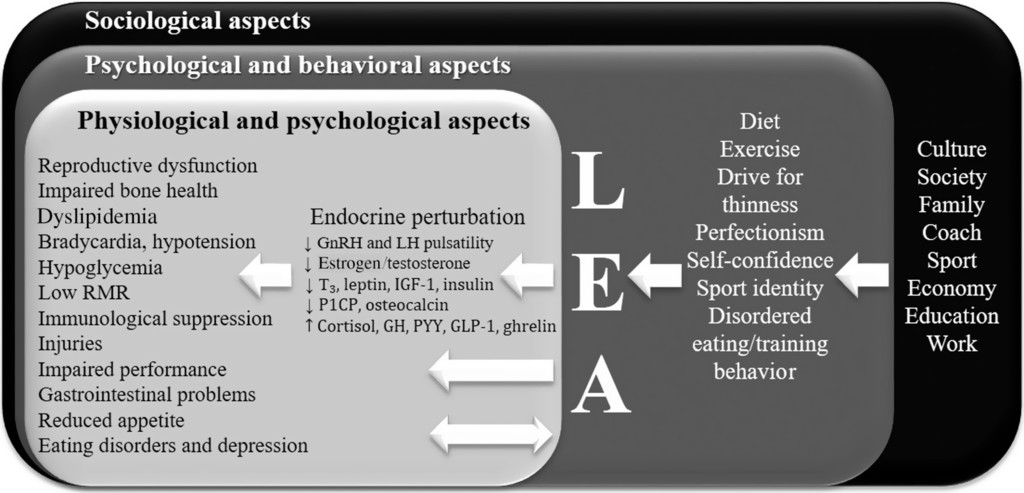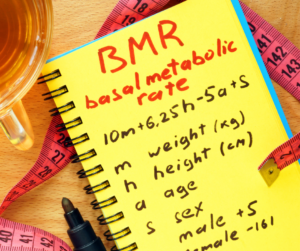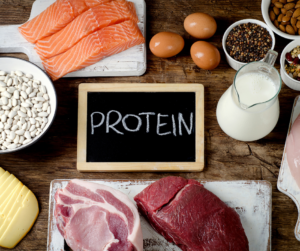Intermittent fasting is currently one of the hottest topics in the health & fitness community. It has become increasingly popularized by a variety of people from medical doctors, to influencers to ‘wannabe’ internet health nuts.
Many recent studies have proven that excessive within-day energy deficits hurt health & performance, even when controlling for daily caloric intake. These studies validate not fasting before training, for males and females.
In other words… by intermittent fasting, by restricting when you consume food…
Women are experiencing menstrual dysfunction, suppressed resting metabolic rates & lower estrogen levels.
Men are experiencing suppressed resting metabolic rates, higher cortisol levels, and lower testosterone levels.
Let’s dive into intermittent fasting…

Intermittent Fasting
Intermittent fasting is a strategy in which you intentionally alternate a period of eating with a period of fasting.
(You do this already when you sleep, but intermittent fasting expands on your normal fasting window)
As athletes ourselves we know that we are always keeping an eye out for the next edge that we can gain over our competitors.
That’s where intermittent fasting came into play…
How Does Intermittent Fasting Work?
All Intermittent fasting strategies are essentially based on choosing regular time periods to eat and fast.
Someone who is intermittent fasting might try eating only during an eight-hour period each day and fast for the rest. Someone else might choose to eat only one meal a day 3 days a week.
What Intermittent Fasting Does To Your Body
Intermittent fasting works by prolonging the period when your body has burned through the calories consumed during your last meal and begins burning fat.
When fasting, your body moves through a fasting cycle, where a number of changes take place:

During the first few hours of eating a meal your blood sugar levels rise, this results in your body secreting insulin. The extra glucose is stored in your muscles as glycogen, this is your body’s primary source of energy and hormones such as Leptin (hunger-suppressing) and Ghrelin (stimulates hunger) shift.
Then, after a good few hours, your insulin & blood sugar levels start to drop, resulting in your body turning glycogen into glucose (energy)
Your body will slowly run out of liver glycogen stores and look for another energy source… say hello to lipolysis. (fat cells break down to be used as energy)
After not eating for 18 hours+ your glycogen stores in the liver have been depleted, and your body begins breaking down protein and fat for energy instead.
Your body will now be in ketosis. (Using fat for energy)
Being in Ketosis will give you a decreased appetite, weight loss, fatigue, bad breath, and increased levels of ketone bodies in the blood.
If you haven’t eaten a meal by now (48hrs after food), this state is referred to as the “Starvation state”. Here, your insulin and BHB levels will rise, your kidneys will generate sugar as energy for your brain, and your branched-chain amino acids (BCAAs) are reduced to help conserve muscle tissue.
After reading what your body goes through during an intermittent fast, it may all seem a bit confusing…
In a nutshell…
You should not fast before training. Let’s have a look at recent studies that prove this statement to be true.
Intermittent Fasting & Running: Why You Shouldn’t
Study Number 1:
This study proves that within-day energy deficits (fasting) can hurt health and performance, especially for female athletes.
Controlling overall daily caloric intake and excessive fasting can have negative impacts on people’s hormones and metabolism. (Impacting bone health & physical adaptation)
Low energy availability (LEA) is when energy expenditure through running and lifestyle is mismatched with energy intake, leading to short-term or long-term caloric deficits, which provide you with health issues.

This diagram taken from the study shows us how low substrate and nutrient availability negatively affects cognitive and physical function and health as well as performance both directly and indirectly.
LEA causes endocrine changes that increase the risk for reproductive and endothelial dysfunction, dyslipidemia, gastrointestinal problems, reduced appetite, injuries, impaired bone health, and immunological suppression.
Study Number 2:
This study looks particularly into the effects of within-day deficits for female athletes.
25 female athletes on the competitive club level between 18 and 38 years old were included in the study.
Firstly the females went through tests related to menstrual function and athletic performance while recording activity and food intake in detail. Within-day deficits were classified as any 1-hour window where the energy deficit exceeded 300 kcal.
Results:
- Athletes with menstrual dysfunction had higher amounts of within-day deficits, even though total daily energy intake was not statistically different.
- Higher within-day deficits led to suppressed resting metabolic rate and lower estrogen levels.
- Within-day deficits led to higher cortisol levels (stress)
From those results we can understand that:
- The reduced metabolic rate from energy deficiency may keep body composition stable, even as the endocrine system changes and health is impacted.
- Within-day deficits can account for menstrual dysfunction due to hourly hormone pulses during different phases of the menstrual cycle.

Study Number 3:
In 2018 a study was conducted.
Subjects consisted of 46 (18-50-year-old) male cyclists, triathletes, and long-distance runners. All subjects were categorized as trained or well trained. 31 subjects (67.4%) were included in the final data analysis.
In this group of men, 65% had suppressed resting metabolic rates and, despite similar EI and 24-hr EB compared with subjects with normal resting metabolic rate, they spent more time in a severe energy deficit and had larger single-hour energy deficit, which was associated with higher cortisol levels and lower testosterone: cortisol ratio.
EI= Energy Intake, EB = energy intake − total energy expenditure) or energy availability.

Study Number 4:
In 2017 a study was conducted to estimate and compare within-day energy balance in athletes with normal menstruation and menstrual dysfunction with similar 24-hour energy availability/energy balance.
The study also investigated whether within-day energy deficiency is associated with resting metabolic rate and an increase in cortisol.
Results:
1. Female athletes with menstrual dysfunction had higher amounts of within-day deficits
2. Higher within day deficits led to suppressed resting metabolic rate & lower estrogen levels
3. Higher within day deficits led to higher cortisol levels
Study Number 5:
This study was conducted to show us that even though Ramadan isn’t a perfect representation of Intermittent fasting, there are still key lessons we can learn.
Ramadan is a religious period in which people are unable to consume food or liquid during daylight hours. (From sunrise to sunset)
It is key to note that the results are slightly skewed as people observing Ramadan are not allowed to consume liquid.
Two Algerian professional soccer teams (55 men) were studied.
Field tests of physical and soccer performance were collected before, in the end, and 2 weeks after Ramadan in 2004. Players were queried on sleeping habits and personal perception of training and match performance.
The study found that performance declined. Speed, agility, dribbling speed, and endurance was reduced during Ramadan. Similarly, just three days of intermittent fasting during Ramadan significantly reduced speed and power ability.
Nearly 70% of the players thought that their training and performance were adversely affected during the fast.

Study Number 6:
Dr. Stacy Sims, author of the groundbreaking book ROAR and the movement Women Are Not Small Men.
Dr. Sims explains that intermittent fasting disrupts a neuropeptide called kisspeptin, (responsible for sex hormones & endocrine & reproductive function) which also plays a role in maintaining healthy glucose levels, appetite regulation, and body composition.
The results: Disrupted hormone production, potentially causing health issues such as menstruation cessation, weakened bones, and impaired recovery.
Study Number 7:
This study proves that intermittent fasting depresses the thyroid and increases cortisol, causing an increase in belly fat. It also causes a decrease in fat burning and an increase in energy deficiency = decrease in performance & muscle breakdown.
Cyclists who ate no breakfast, (intermittent fasting) were studied and it was found that performance declined by 3%. A lot of people choose to fast intermittently to burn fat and lose weight… this study proves that the cyclists who ate no breakfast experienced a DECREASE in fat burning.

Now that we have had a look at 7 different studies validating not intermittent fasting before running, let’s have a look at some key takeaways.
By fasting as a woman, you could cause yourself menstrual dysfunction, suppressed resting metabolic rates, lower estrogen levels, compromised training adaptations, and performance levels.
By fasting as a man you could cause yourself suppressed resting metabolic rates, higher cortisol levels, lower testosterone levels, decreased performance and decreased fat burning.
The point is that you need to consume sufficient energy and nutrients in your pre and post-training meals.
These pre and post-training meals need to consist of a good amount of healthy protein and good carbohydrates. Research shows that eating 20-40g of protein every 3-4 hours provides a small advantage regarding muscle protein synthesis.
So many people are still getting the message that intermittent fasting and even the Keto diet are what you need to do to gain mental focus, high performance, and weight loss….
Now that we know it’s all not true and that you most certainly should not be fasting as an athlete…. Is it ever okay to fast?

When Is It Okay To Intermittent Fast?
For the people who don’t exercise and don’t lead active lifestyles, for the people struggling with metabolic diseases… then it can be useful to fast, bearing in mind that while the attraction of losing weight by controlling your hunger sounds good, there are some long-term and irreversible side effects of intermittent fasting.
But if you are already running and adding intermittent fasting into your strategy, then think again as it does more harm to your body than good.
Check out this video where Coach Linsey Parry chats to Brad Brown about eating breakfast before a run. https://www.youtube.com/watch?v=dtkJ2QWlDx4




Comments are closed.